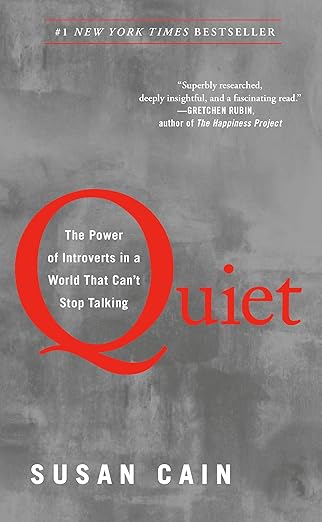“... bear in mind that appearance is not reality. Some people act like extroverts, but the effort costs them energy, authenticity, and even physical health... - Susan Cain
For many introverts, like me, this book was revolutionary. It was a call to arms for the millions of people who don't like parties, find small talk difficult and 'just want to be alone'. There still are millions of introverts who think there is something wrong with them, and even more extroverts who also think there's something wrong with the introverts. There is A LOT to take away from this book and no synopsis or summary will do it justice. Especially because it's a crisis that affects 2 billion people. But, if there is one thing I've learned on this topic it's that extroverts don't want attention; they want company. And introverts don't want solitude, they want calm. And company and calm are not mutually exclusive.
Synopsis
This is a Google Gemini synopsis of Quiet: The Power of Introverts in a World That Can’t Stop Talking, by Susan Cain from 2012.
Here are seven key points from the book:
Defining Introversion and Extroversion: Cain introduces the fundamental differences between introverts and extroverts, emphasising that it is not about shyness but about how individuals respond to external stimulation and where they draw their energy from.
The Rise of the Extrovert Ideal: The book traces the historical shift in Western culture, particularly in America, from valuing character and introspection to celebrating personality and outward charm, leading to the “extrovert ideal.”
The Power of Introverts in the Workplace: Cain provides examples of how introverted traits such as deep focus, careful consideration, and independent work styles are often undervalued in team-oriented environments, despite their significant contributions to innovation and problem-solving.
The Brain Science of Introversion: The author delves into the biological basis of introversion, exploring research on the amygdala, dopamine pathways, and the nervous system’s response to stimuli in introverted and extroverted individuals.
Parenting and Teaching Introverted Children: Cain offers guidance on how to nurture introverted children, advocating for environments that respect their need for quiet and independent play, rather than pushing them towards constant social engagement.
Love and Relationships: The book examines the dynamics of relationships between introverts and extroverts, highlighting the importance of understanding and appreciating each other’s communication styles and energy needs.
Embracing Your Quiet Self: Ultimately, Quiet encourages introverts to embrace their inherent strengths and for society to recognise the immense value that quiet individuals bring to all aspects of life, from leadership to creativity.
Susan Cain’s Quiet makes a compelling case for the often-overlooked strengths of introverts in a world that frequently champions extroverted ideals. She begins by clearly defining the characteristics of introversion and extroversion, explaining that the distinction lies not in social anxiety but in an individual’s response to stimulation and their source of energy. Introverts, she argues, thrive in calmer environments and recharge through solitude, while extroverts gain energy from social interaction and external stimuli.
Cain then explores the historical context of how the “extrovert ideal” came to dominate Western society, particularly in America, shifting from a culture that once valued quiet contemplation to one that prioritises outward charisma and assertiveness. She provides numerous examples across various domains, including education and the workplace, to illustrate how this cultural bias often leads to the underestimation of introverted talents. The book presents a wealth of scientific research, delving into neuroscience and psychology to explain the biological underpinnings of introversion, making the case that these traits are not merely personality quirks but are rooted in distinct brain chemistry.
A significant portion of Quiet is dedicated to practical implications, offering advice for parents raising introverted children, for introverts navigating the challenges of an extroverted world, and for organisations seeking to harness the full potential of all their employees. Cain advocates for a more balanced approach, one that values both the dynamic energy of extroverts and the thoughtful, often profound, contributions of introverts. Ultimately, Quiet serves as an insightful guide for both introverts and extroverts, fostering a greater understanding and appreciation for diverse temperaments and encouraging a society that makes room for all types of personalities to thrive.
Key Points
- Introverts: deep, calm, focused.
- Extroverts: social, active, bold.
- Society favours outward charm.
- Quiet strengths often overlooked.
- Brain science explains differences.
- Embrace your true self.

